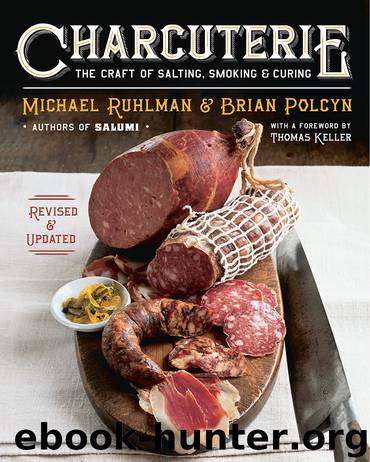Charcuterie by Michael Ruhlman

Author:Michael Ruhlman
Language: eng
Format: epub
Publisher: W. W. Norton & Company
Published: 2013-08-01T04:00:00+00:00
5 feet/1.5 meters hog casings or 10 feet/3 meters sheep casings, soaked in tepid water for at least 30 minutes and rinsed
1. Grind the meat through a small die (see Note below).
2. Combine the meat with the salt, pink salt, and water and mix by hand to distribute the salts. Cover and refrigerate for 24 to 48 hours.
3. Add the remaining ingredients and mix in by hand, then spread this mixture onto a sheet tray and place it in the freezer until the meat is so cold that it’s stiff, about 30 minutes or longer, depending on the freezer.
4. Regrind the mixture through a small die.
5. Return mixture to the sheet tray and place it in the freezer until it is again so cold that it’s stiff.
6. Place the mixture in a food processor and puree until it is a uniform paste, about 1 to 2 minutes (if your food processer is not strong enough to do this much meat, simply puree in two batches). It’s important not to let the mixture get warm.
7. Stuff the mixture into casings and twist into 6-inch/15-centimeter links. Hang on smoke sticks and hot-smoke (see page 77) to an internal temperature of 140 degrees F./60 degrees C. Transfer to an ice bath to chill thoroughly.
Yield: About 21⁄2 pounds/1 kilogram hot dogs; about ten 6-inch/15-centimeter links or, if using sheep casings, ten 12-inch/30-centimeter links
[ NOTE: See pages 135–140 for a detailed description of the basic grinding, mixing, stuffing, and cooking techniques. ]
Basic Uncooked Smoked Sausage Technique
This method is identical to the smoked and cooked sausage technique in all ways except temperature; the sausages are smoked at temperatures too low to cook them. Because they are not fully cooked after smoking, they must be cooked before serving. These sausages are typically not eaten on their own, but rather as a component of another dish, such as a paella.
If you don’t have a smoker that can cool the smoke somehow, there are few ways to achieve some level of cold-smoking. If you live in a northern latitude, smoke when it’s freezing cold outside, opening the smoker door every so often to let in cold air—it’s worth the loss of smoke. At other times and other latitudes, you can put a tray of ice directly above the smoke, which will cool the smoke.
Once these sausages are smoked, they are dried for several days, which helps to intensify their flavor.
They’re typically coarse sausages, powerfully flavored.
HUNGARIAN PARIKA SAUSAGE
The cold-smoked method results in a dense, flavorful sausage. This particular sausage is all about the paprika—use the best quality you can find. It can be hot or sweet or a combination of both, depending on your tastes, but if you have access to great Hungarian paprika, that’s the one to choose for this sausage.
1 pound/450 grams boneless lean beef (stew beef, chuck roast, round), fat and sinew removed, diced
2 1⁄2 pounds/1 kilogram boneless pork shoulder butt, diced
1 pound/450 grams pork back fat, diced
3 tablespoons/40 grams kosher salt
Download
This site does not store any files on its server. We only index and link to content provided by other sites. Please contact the content providers to delete copyright contents if any and email us, we'll remove relevant links or contents immediately.
My Pantry by Alice Waters(2542)
The Culinary Herbal by Susan Belsinger(2429)
Food and Water in an Emergency by Food & Water In An Emergency(2339)
Asian Pickles: China by Karen Solomon(2093)
Project Smoke by Steven Raichlen(1995)
Food Storage for Self-Sufficiency and Survival by Angela Paskett(1985)
Smoke & Spice by Cheryl Alters Jamison(1882)
The Jam and Marmalade Bible by Jan Hedh(1614)
Pure Charcuterie: The Craft & Poetry of Curing Meat at Home by Meredith Leigh(1607)
Fermented Vegetables by Kirsten K. Shockey(1521)
Economic Food Storage Strategies for Disaster Survival: Start Today and Have Enough Food Your Family Will Eat to Survive Any Disaster Without Going Broke by Sandy Gee(1504)
Asimov's Science Fiction 020111 by Dell Magazines(1504)
Asian Pickles by Karen Solomon(1451)
Canning for a New Generation by Liana Krissoff(1414)
The Ideal Pantry: Your Comprehensive Guide to Food Remedies and Preservation Techniques by Ben Night(1412)
The Healthy Meal Prep Cookbook: Easy and Wholesome Meals to Cook, Prep, Grab, and Go by Amidor RD CDN Toby(1394)
Not Just Jam: The Fat Pig Farm book of preserves, pickles and sauces by Evans Matthew(1367)
The Complete Guide to Drying Foods at Home: Everything You Need to Know About Preparing, Storing, and Consuming Dried Foods by Paajanen Terri(1313)
Jams, Preserves and Chutneys by Marguerite Patten(1304)
